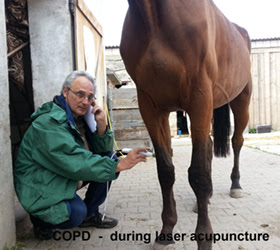Approaches to Laser Therapy in Horses
“Laser” stands for Light Amplification by Stimulated Emission Rays. Lasers direct highly concentrated light at a specific wavelength to muscles, tissues, organs and connective tissue. As with other veterinary equipment, not all lasers are created equal. Some are technically easier to operate than others. Some work faster and deliver more efficient energy. And some have settings that allow us to simply push a few buttons and wait for the laser to do the rest.
Virtually all laser therapy for horses work their magic through the same mechanism – that is, emission of light at a specific wavelength to facilitate the horse’s innate ability to heal him. Laser therapy for tendon injuries can be approached in two different ways.
1. Reactive approach to tendon injury
A client calls with an issue, and we motor out with a solution. With tendon issues, the reactive veterinarian may employ a combination of methods such as NSAIDs, hot and cold therapy, and a change in shoeing. Some veterinarians may even use intra-lesion injections such as stem cell, platelet-rich plasma or some other novel technique.
2. Proactive approach to tendon issues
The majority of tendon injuries arise from overuse, so using a laser proactively on tendons and ligaments may be the best use of laser in equine practice. The owner benefits by staying ahead of the game as you keep her horse sound. And the trainer looks good because his reputation for keeping horses sound and serviceable remains intact.
For more details on this, please browse www.rj-laser.com.


Comments
Post a Comment